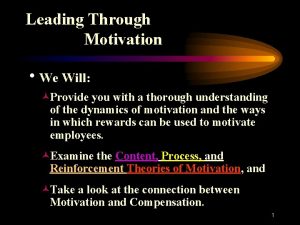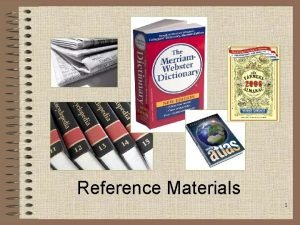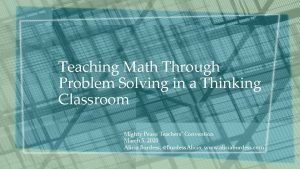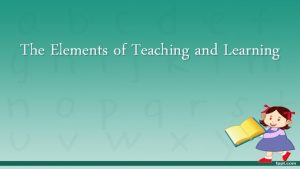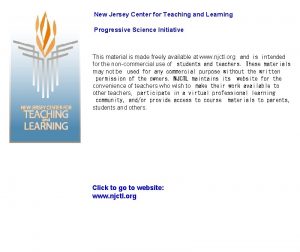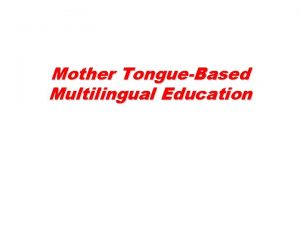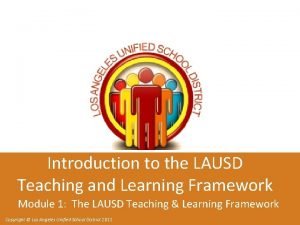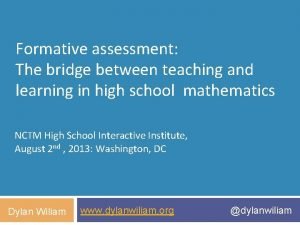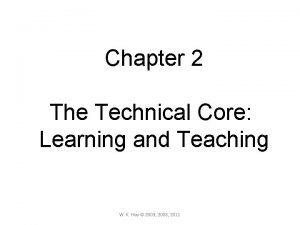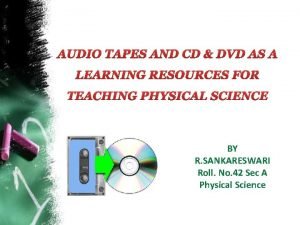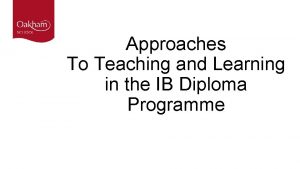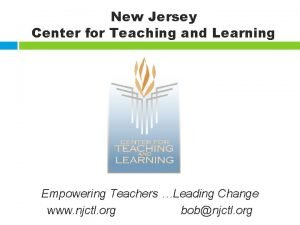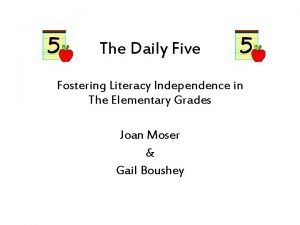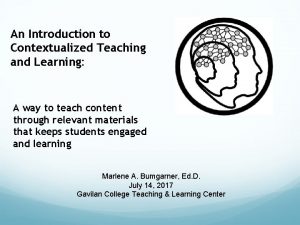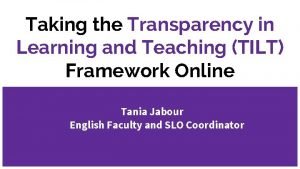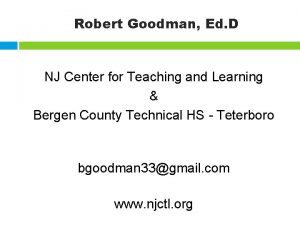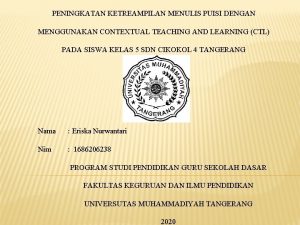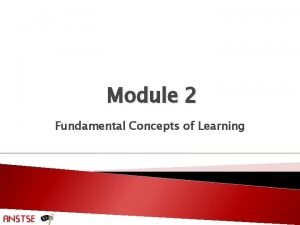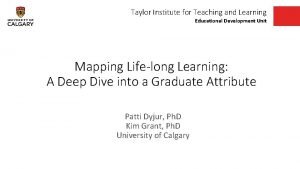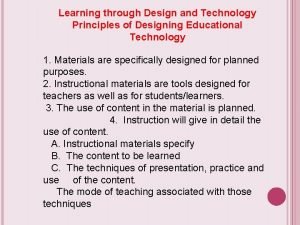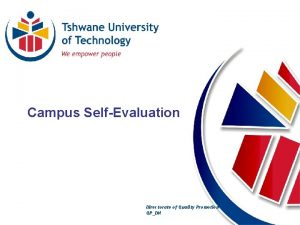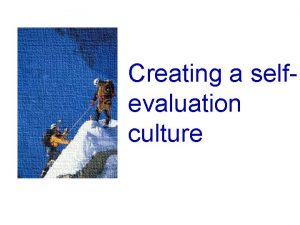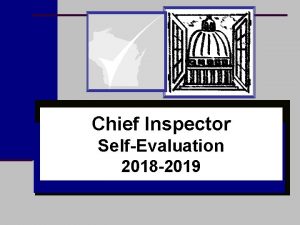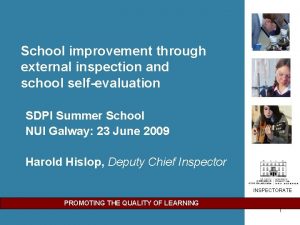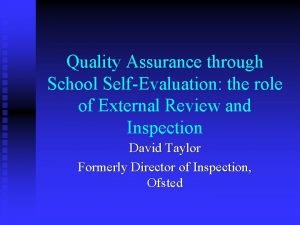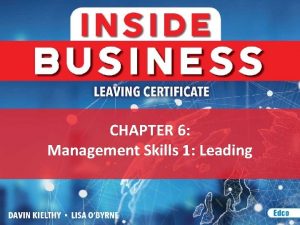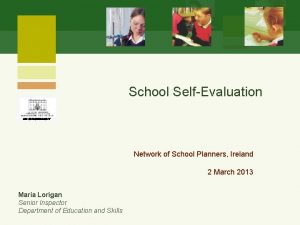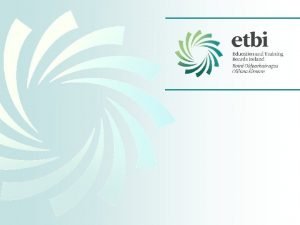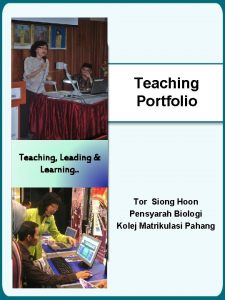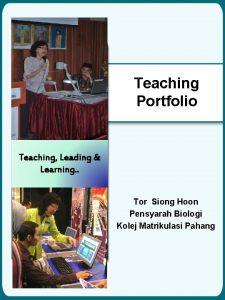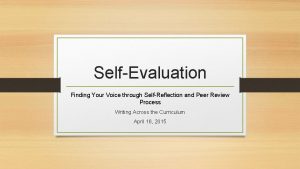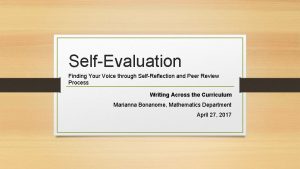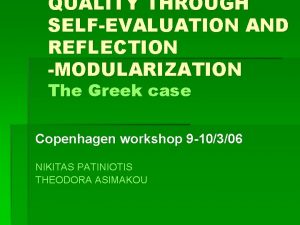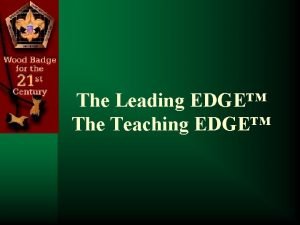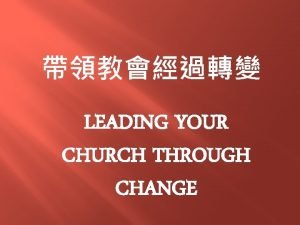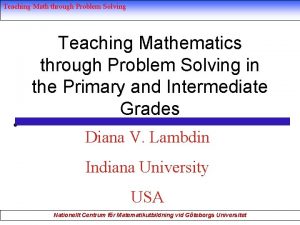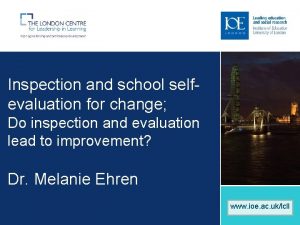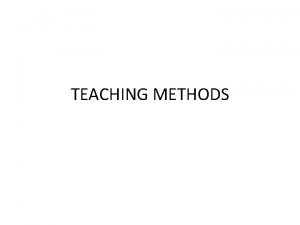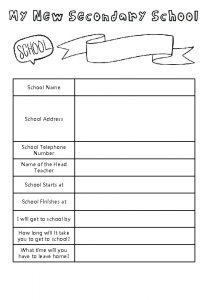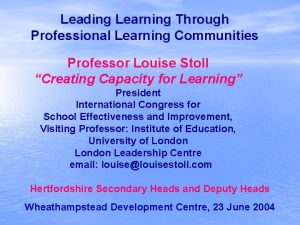Leading Teaching and Learning through School SelfEvaluation NAME






























- Slides: 30

Leading Teaching and Learning through School Self-Evaluation NAME AND NAME DATE AN CHIGIREACHT

Purposes of the Session To reflect on your school’s progress with SSE to date, and to consider your school’s next steps in SSE To explore how Looking at Our School 2016 can be used to support and inform the six-step SSE process To revisit some of the key messages with regard to SSE and to prepare to reengage with the process

Some fundamental principles of school self-evaluation All schools are on a journey of improvement. SSE is a way for schools to identify their priorities and engage in school improvement. SSE is a collaborative process of whole-school reflection. The context for each school is different – so SSE will look different in each school. Improving learning – every classroom, every teacher, every day SSE provides a process which schools may use to manage change. Eg Primary Language Curriculum

Critical questions in school self-evaluation Critical SSE Questions How well are we doing? What are our strengths? What are our areas for improvement? How can we improve?

Reflection / Discussion In your school in the past: What worked well with regard to SSE? What impact, did SSE have on teaching and learning? What would you change / do differently?

The school self-evaluation process

Second cycle of school self-evaluation 2016 -2020 – Circular 0039/2016 Continue to focus on teaching and learning Looking at Our School 2016 to inform the SSE process Flexibility to focus SSE on curricular areas or aspects of teaching and learning Continue to monitor progress in literacy and numeracy Schools will use the SSE process to assist in introducing and embedding national initiatives e. g. Primary Language Curriculum

Circulars 0039/2016 In DEIS schools, the DEIS planning process is SSE – the DEIS plan is the school improvement plan Annual brief record of SSE in a combined SSE report and SIP and BOMs to complete an annual policy and legislative checklist Communicate summary SSE report and SIP to school community each year

Where are we now? Circular 0016/2018 has issued Amends but does not replace circular 0039 / 2016 – most aspects remain the same Communicates revised expectations Schools should conduct self evaluations and plan for improvement in either one or two curriculum areas / aspects of teaching and learning between now and June 2020 Period between up to June 30 2018 Reflect on and review previous SSE work – embedding practice and maintaining improvement Identify first area of focus and engage in the investigative phase (Steps 1 – 4) Ready to commence the implementation phase early in the 2018 / 19 school year

Looking at Our School 2016:

A quality framework for schools Provides a unified and coherent set of standards for two dimensions of the work of schools teaching and learning leadership and management Supports meaningful dialogue about quality in schools shared professional language shared understanding of what effective teaching, learning, leadership and management practices look like Informs school self-evaluation and external evaluation

Looking at Our School 2016 – Key Principles Holistic view of learning – broad, balanced, challenging, responsive to learners’ needs Pupils’ well-being intrinsic to learning – outcome and enabler of learning Quality teaching as a powerful influence on achievement – career long professional development Pupils as active agents in learning Schools as dynamic learning organisations – individual and collective work to build capacity towards improvement External and internal evaluation as complementary contributors to school improvement Leadership and management inseparable Leadership encompasses both formal roles and teacher leadership

Key Principles – Task Look at the eight principles Discuss them with those around you Which one(s) resonate immediately with you? Which one(s) are more challenging?

DIMENSIONS DOMAINS Learner outcomes Teaching and Learning Learner experiences Teachers’ individual practice Teachers’ collective/ collaborative practice Leading learning and teaching Leadership and Management Managing the organisation Leading school development Developing leadership capacity STANDARDS

Thinking about the domains of teaching and learning DIMENSION DOMAINS Learner outcomes Teaching and Learning Learner experiences Teachers’ individual practice Teachers’ collective/ collaborative practice

Standards for Learner Outcomes Pupils enjoy their learning, are motivated to learn, and expect to achieve as learners Learner outcomes Pupils have the necessary knowledge and skills to understand themselves and their relationships Pupils demonstrate knowledge, skills and understanding required by the primary curriculum Students attain the stated learning outcomes for each subject, course and programme

Four standards in each domain

The language of evaluation drawn from Looking at Our School Highly Effective

Statements of practice for each standard

Helping schools to sharpen their focus Critical SSE Questions Rephrased using Looking at our School 2016 How well are we doing? How close is our practice to the statements of effective practice? What are our strengths? What areas of our practice are highly effective? What are our areas for improvement? Where are we not yet reaching effective practice? How can we improve? How can we work towards (highly) effective practice?

Using Looking at Our School in the sixstep SSE process: Workshop

Step 1: Identify Focus

Task Area of focus is defined: Learning outcome 4 (Gaeilge) For Discussion: Identify Focus: How can the domains help you to think about the area of focus? Gather Evidence: Which standards would you use to focus your evidence gathering? Analyse and make judgements: How would you use the statements of effective and highly effective practice to make judgements about your school?

STEP 4: WRITE AND SHARE REPORT AND IMPROVEMENT PLAN

STEP 5 and 6 Every classroom Every teacher Every day Monitoring Evaluate Impact and change if necessary

Other Examples: Scenario Schools presented in Update 8 and 9 Primary Oakleaf Primary School – focus on Oral Language (Primary Language Curriculum) Ballymartin National School – focus on Digital learning They explore how the quality framework might be used to support the SSE process Steps 1 to 4 of the process are explored in detail Other scenario in preparation for the SSE website

Inspectorate Supports to Schools SSE Advisory visits Requests through SSE website and info@schoolself-evaluation. ie Materials already sent to primary schools in March Hard copy of the amending circular 0016/2018 Hard copy of circular 0039/2016 Hard copy of SSE update 10 Materials being sent to all primary schools in April An additional hard copy of the SSE Guidelines An additional had copy of Looking at Our School 2016

SSE Website and Social Media SSE website – www. schoolself-evaluation. ie Videos Webinars Templates Samples of good practice The SSE Update – twice yearly SSE Twitter feed SSE Facebook feed

Joining the dots Looking at Our School 2016: a framework A set of clear, definable standards in two dimensions: § teaching and learning § leadership and management School self-evaluation: a process • • A process of internal review A way of working that enables schools to focus on implementing change and effecting improvement in teaching and learning Circular 0063/2017: a model of leadership • • • Distributed leadership Flexible - to ensure responsibilities match school priorities Focused on pupil/student learning – experiences and outcomes

30
 Objectives of roving frame
Objectives of roving frame Leading through motivation
Leading through motivation Leading through change presentation
Leading through change presentation Tangential sawing
Tangential sawing Name all the rays
Name all the rays Differences between micro teaching and traditional teaching
Differences between micro teaching and traditional teaching Cuadro comparativo e-learning y b-learning
Cuadro comparativo e-learning y b-learning Look through the reference material and the map and name
Look through the reference material and the map and name By one man sin
By one man sin Furcation
Furcation Night of the scorpion ppt
Night of the scorpion ppt Alicia burdess teaching through problem solving
Alicia burdess teaching through problem solving Appetitive faculties of a learner
Appetitive faculties of a learner New jersey center for teaching and learning
New jersey center for teaching and learning New jersey center for teaching and learning
New jersey center for teaching and learning End goals of mtb-mle
End goals of mtb-mle Teaching learning framework lausd
Teaching learning framework lausd Assessment the bridge between teaching and learning
Assessment the bridge between teaching and learning Technical core: teaching and learning
Technical core: teaching and learning Uses of cd and dvd in education
Uses of cd and dvd in education Approaches to teaching and learning ib
Approaches to teaching and learning ib New jersey center for teaching and learning
New jersey center for teaching and learning 10 steps to teaching and learning independence
10 steps to teaching and learning independence Impact of assure model to students
Impact of assure model to students Contextualized learning examples
Contextualized learning examples Transparency in learning and teaching
Transparency in learning and teaching Nj center for teaching and learning
Nj center for teaching and learning Contextual teaching and learning
Contextual teaching and learning Styles of learning and teaching
Styles of learning and teaching Taylor institute for teaching and learning
Taylor institute for teaching and learning Learning through design and technology
Learning through design and technology

